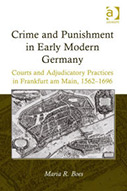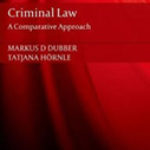Crime and Punishment in Early Modern Germany: Courts and Adjudicatory Practices in Frankfurt am Main, 1562–1696

Author: Maria R. Boes
Publisher: Farnham, Surrey, UK; Burlington, VT: Ashgate, 2013. 292p.
Reviewer: Jason P. Coy | September 2015
Maria Boes’s study of law enforcement in early modern Frankfurt am Main is based upon detailed analysis of cases from the city’s Strafenbuch, a list of punishments handed down between 1562 and 1696. Using these records, Boes seeks to trace “the proliferation of increasingly disproportionate, selective adjudicatory practices” that targeted certain social outsiders in early modern Frankfurt (ix). She argues that by the end of the sixteenth century, the introduction of Roman Law led to the persecution of these disadvantaged groups, including gypsies, Jews, women, and suicides.
After a brief preface (2 pages), Boes provides a series of case studies of how law enforcement in early modern Frankfurt affected various social groups. Chapter 1 provides an introduction to social and economic changes in the city during the early modern period, with an emphasis on how they fostered the stigmatization of unwanted outsiders in the city. The next chapter explores how these social and economic shifts affected the legal and judicial realm with the implementation of Roman Law and the triumph of educated humanist lawyers, developments that augmented the power of the city’s closed patrician elite. Chapter 3 examines judicial procedures in Frankfurt, focusing on the role of eyewitness testimony in identifying suspects in an era before formal police forces. The rest of the book attempts to demonstrate how Frankfurt’s new legal and judicial procedures worked to the detriment of various disadvantaged groups: gypsies in chapter 4, Jews in chapters 5 and 6, and women in chapters 7, 8, and 9. The chapters on women focus primarily on infanticide prosecution. Chapter 10 continues the theme of illicit sexuality, examining sodomy cases. Chapter 11, on the punishment of soldiers, shows how Roman Law worked to enhance the legal standing of soldiers and seems a bit out of place. Ultimately, for Boes, it serves as an exception that proves the rule of legal and judicial discrimination in early modern Frankfurt. Chapter 12 returns to the topic of discrimination, exploring the judicial treatment of suicide. In her conclusion, Boes attempts to tie her diverse case studies together, arguing that “Roman Law had a decisively negative effect on many people. It served to strengthen the power of male rulers at the expense of the less fortunate such as peasants, many women, gays and even suicides” (267).
Boes’s argument about the effect of the era’s sweeping legal and judicial changes on Frankfurt’s social outsiders is compelling, and she provides many interesting insights about early modern law enforcement in her detailed analysis of her source material. However, several questions remain. It is unclear how representative her findings are, since most of her chapters are based on a very small number of sources: 4 cases involving gypsies in chapter 4, 11 cases involving Jews in chapter 5, one infanticide case in chapter 8, two such cases in chapter 9, and just 2 sodomy cases in chapter 2. The topics of the various chapters are interesting in their own right, but the larger argument is sometimes difficult to follow. The book lacks a true introduction, which might have helped unify the chapters and accentuate the main argument. In addition, Boes does not always cite the most recent or pertinent literature on the subjects she covers—on public punishment, for example, she doesn’t cite a single source published within the last 25 years. Finally, I found the author’s use of anachronistic language to be a distraction. For example, she labels assaults on Jews in early modern Frankfurt as “hate crimes” (99), and she refers to those convicted of sodomy as “gays” (267). Despite these shortcomings, the case studies she presents in this book should be of great interest to scholars working on the law in early modern Germany.
Jason P. Coy, Associate Professor, Department of History, College of Charleston


